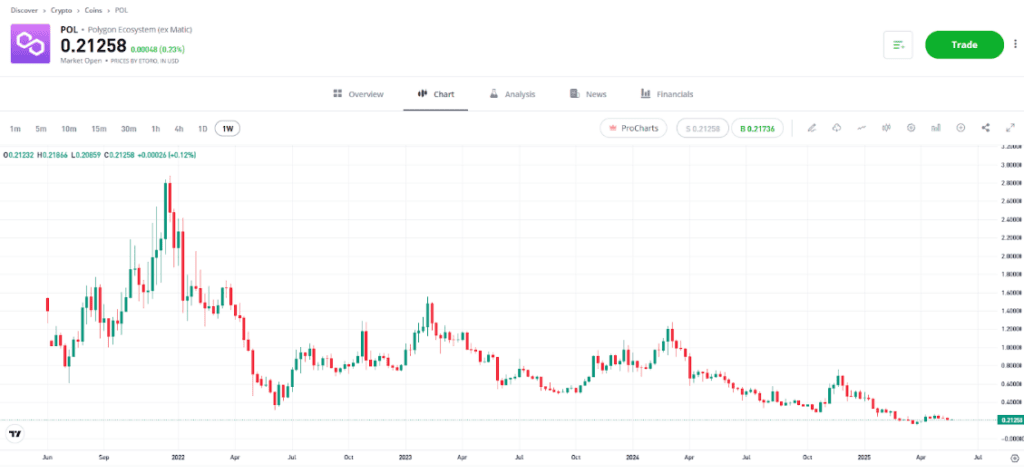Polygon was designed to address speed, scalability and cost efficiency issues within decentralised finance (DeFi). Learn what Polygon is and what makes it unique, and what the future might hold for the price of MATIC.
How does Polygon (MATIC) work?
Polygon is a

Polygon acts as a bridge, seamlessly connecting different chains, enabling
To help scale the Ethereum network, Polygon has integrated a range of different scaling solutions to help it overcome the network’s capacity limitations, while still ensuring compatibility with existing Ethereum-based assets. This includes using zkRollups, a method of bundling Ethereum transactions into batches and executing them off-chain, and
Polygon has a vibrant ecosystem and a range of use cases. It enables developers to create
The Polygon blockchain uses a
What makes Polygon different?
Polygon aims to bring mass adoption to Ethereum and blockchain technology. By offering a scalable, secure and user-friendly platform for building and connecting dApps, Polygon hopes to create a multi-chain system that can support the diverse needs and demands of the crypto community.
Polygon is fully compatible with Ethereum’s tools and standards, including the following:
- Ethereum Virtual Machine (EVM) — software that executes smart contracts on the Ethereum blockchain
- Solidity — a programming language created by Ethereum developers
- MetaMask — an Ethereum-based cryptocurrency wallet
This means that developers can easily deploy their existing Ethereum applications on Polygon, without needing to make any major changes.

What is the MATIC price and forecast for the future
MATIC is Polygon’s native cryptocurrency, and one of the key reasons that investors are interested in the Polygon network.
| Year | Start Price | Mid-Year Price | End Price | Percentage Change |
|---|---|---|---|---|
| 2019 | – | $0.022 | $0.014 | -36% |
| 2020 | $0.014 | $0.019 | $0.018 | 29% |
| 2021 | $0.018 | $1.167 | $2.528 | 13,944% |
| 2022 | $2.528 | $0.478 | $0.759 | -70% |
| 2023 | $0.759 | $0.661 | $0.971 | +28% |
| 2024 | $0.971 | $0.560 | $0.451 | -54% |
Prices have been rounded to three decimal places | Past performance is not an indication of future results
Source: Yahoo! Finance
While the price of Polygon has posted some impressive annual returns there have also been years where it has lost over half of its value. These price drops have coincided with bearish sentiment dominating the wider crypto market but it is unclear whether Polygon’s cryptocurrency will be able to stand the test of time.

Past performance is not an indication of future results
Source: eToro
The team behind Polygon has continued to build new applications and create additional partnerships with reputable brands. Moving forward, it is clear that DeFi and NFTs will be key areas of focus for the Polygon platform, thus potentially impacting the price of MATIC. That being said, cryptocurrencies are a
“Polygon has evolved into a multichain powerhouse, providing developers and creators with the tools they need to build innovative, secure, and scalable blockchain solutions.”
Polygon Wiki
Who created Polygon?
Polygon was founded in India in 2017 by Jaynti Kanani, Sandeep Nailwal, Anurag Arjun and Mihailo Bjelic, who understood that congestion on the Ethereum network would eventually hinder the blockchain significantly.
Tip: Plasma chains are separate blockchains, attached to the Ethereum mainnet which improves scalability while still benefitting from Ethereum’s security.
Polygon offers an additional layer for scaling Ethereum-based applications and its native cryptocurrency MATIC, rose to prominence during the 2021 cryptocurrency bull market, positioning itself as a cheaper alternative for making transactions on Ethereum. During this time, a number of projects in DeFi and the

Since its inception, Polygon has partnered with several prominent and well-known brands for various crypto projects, such as Disney, Reddit and Starbucks, although Disney has since pulled funding for its metaverse project.
Today, Polygon continues to have a strong focus on technological developments and providing a more scalable and interconnected multi-chain ecosystem. It hosts a variety of dApps in different domains, such as gaming, NFTs, DeFi, identity and social mediapopular dApps on Polygon include Aavegotchi, Decentraland, QuickSwap, SushiSwap and OpenSea.
Final thoughts on investing in Polygon
Polygon is arguably one of the most ambitious projects in crypto, demonstrated by its ability to become such an influential blockchain within just a few years of its launch.
The platform’s close ties with Ethereum have proven to be instrumental in helping Polygon gain a significant user base in a short period of time, although there is potential for Polygon to increase its independence in the future, utilising its own gas token, MATIC, rather than Ethereum’s.
Visit the eToro Academy to learn more about investing in cryptocurrencies.
FAQ
- How are Ethereum-based cryptoassets transferred to Polygon?
-
There are a variety of ways to transfer assets from Polygon to Ethereum, and vice versa. Two bridges, known as the Proof of Stake bridge and the Plasma bridge, are available to swap assets between Polygon and Ethereum in a decentralised manner. In addition, users can effectively swap between the two chains via some centralised exchanges.
- What is MATIC used for?
-
MATIC is the native gas token of the Polygon blockchain. MATIC is needed to interact with Polygon’s decentralised applications and complete transactions on the network. In addition, MATIC can be staked by network validators in order to participate in network consensus and earn rewards.
- Why are Polygon transactions cheaper than Ethereum transactions?
-
There are two key factors that cause Polygon transactions to be cheaper than Ethereum (ETH) transactions. First, Polygon is willing to be more centralised in an effort to increase total transaction capacity. Secondly, there is simply more demand for transactions on the Ethereum blockchain, which increases the gas fees required to complete them.
This information is for educational purposes only and should not be taken as investment advice, personal recommendation, or an offer of, or solicitation to, buy or sell any financial instruments.
This material has been prepared without regard to any particular investment objectives or financial situation and has not been prepared in accordance with the legal and regulatory requirements to promote independent research. Not all of the financial instruments and services referred to are offered by eToro and any references to past performance of a financial instrument, index, or a packaged investment product are not, and should not be taken as, a reliable indicator of future results.
eToro makes no representation and assumes no liability as to the accuracy or completeness of the content of this guide. Make sure you understand the risks involved in trading before committing any capital. Never risk more than you are prepared to lose.


